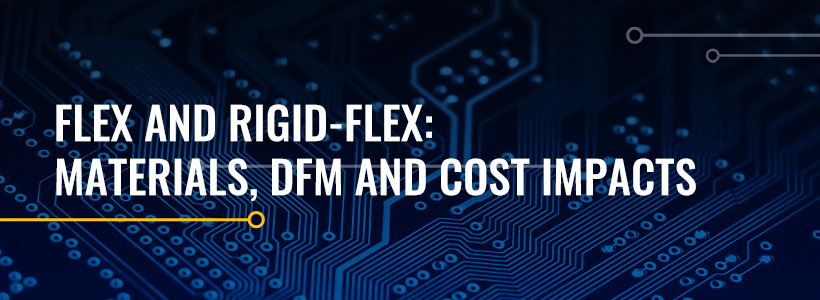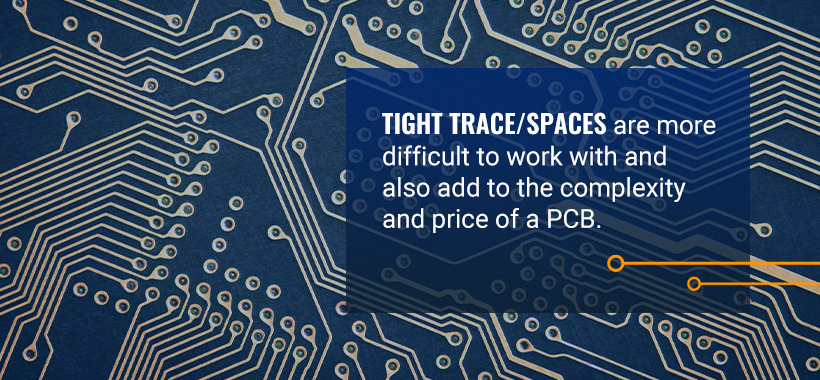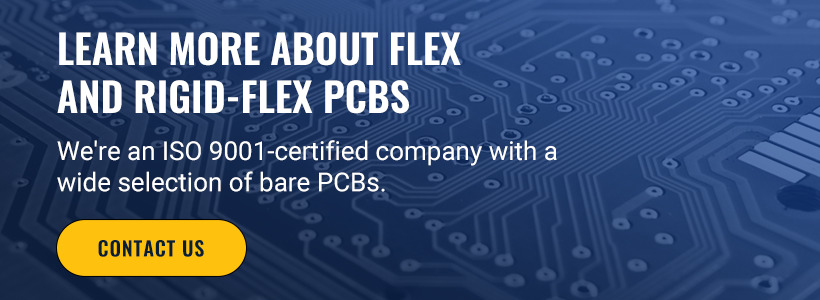Table of Contents:
- What Are Flex And Rigid-Flex PCBs?
- Cost Drivers For Rigid-Flex PCBs And Flexible PCBs
- Trade-Offs In Cost For Flex And Rigid-Flex PCBs
Flex and rigid-flex printed circuit boards (PCBs) are a versatile, advantageous option for PCB designers, offering benefits like flexibility, lightweight materials and durability. While rigid PCBs are totally inflexible, flex PCBs and rigid-flex PCBs can bend and twist onto themselves. They’re often necessary for small and light products like electronics that need to maximize space and weight.
These PCBs are more expensive than their rigid counterparts. Fortunately, you can bring down the costs in a few different ways. We’ll go over the basics of rigid, flex and rigid-flex PCB materials, costs associated with them and some of the biggest design-for-manufacturing (DFM) considerations affecting PCB costs.
What Are Flex and Rigid-Flex PCBs?
Flexible or Flex PCBs are also called flex circuits and can be fully bent to a specific shape. To make one, manufacturers laminate a layer of transparent polyester film, such as polyimide, to a thin sheet of copper. The copper is then etched away to leave the specific PCB pattern in place. A rigid-flex PCB takes the best of both worlds, combining rigid PCB materials with flexible circuits.
Although flex and rigid-flex boards are more expensive than rigid boards, they can help reduce costs in other ways. You can reduce material needs, enjoy quicker assembly and achieve a variety of advantages for design flexibility.
Cost Drivers for Rigid-Flex PCBs and Flexible PCBs
Manufacturing is heavily affected by the number of steps involved and the materials required. Of course, these will drive up the cost. By understanding where the biggest costs come from, you can tweak your design for a more economical board that still offers the performance and cost savings you need down the road.
Least Influential
Some of the factors that only have a minor impact on your PCB’s cost include:
- Routing: As with rigid boards, more complex routing will increase the cost of manufacturing since it requires more precision.
- Panel thickness: Going with thinner, more common panel sizes generally saves you money.
- Via plugging: Via plugging calls for the extra step of completely filling in vias with resin or solder mask. If you can limit instances of via plugging, you can save on costs.
- Strain relief: Similarly, limiting the need for strain relief and its associated materials can help you save money too.
- Adhesive: PCBs can use adhesive or adhesiveless cores to bond the stiffener to the board. The most affordable adhesive material will vary depending on your stiffener, but adhesiveless materials are the more expensive option overall.
More Influential
These next factors will more significantly influence the cost of your flex or rigid-flex PCB:
- Aspect ratio: A larger aspect ratio between the thickness of the PCB and the diameter of a drilled hole makes it more difficult and time-consuming to plate the inside of the holes and can increase the PCB’s cost. You’ll need to either keep the drilled holes to a larger size or reduce the size of the PCB to find a good ratio for plating.
- Number and size of drilled holes: If your board has excessive drill holes, the cost will go up due to the additional labor and complexity. Similarly, smaller holes require more specialized tools and precision, so they can add to the cost, as well.
- Trace and space size: Tight trace/spaces are more difficult to work with and also add to the complexity and price of a PCB.
- Stiffeners: Stiffeners or rigidizers will increase costs due to the additional material requirements. Its thickness will also affect the price. If you need a stiffener, you can save on costs if you can stick to FR4. This material is versatile and common, but polyimide, aluminum or stainless steel are more expensive.
- Button or selective plating: You’ll increase the price of a PCB if you use any kind of button or selective plating due to its added complexity.
- Controlled impedance: If you opt for controlled impedance, the manufacturer uses additional checks and coupons that require more labor and materials.
- Annular rings: Your annular rings should be large enough to create a reliable connection with the via, but if it’s too big, you’ll likely pay more for it.
Most Influential
Finally, the factors that play the biggest role in the price of your PCB include:
- Advanced technologies: If you opt for more advanced technologies in your PCB, you’ll be looking at higher costs.
- Buried vias: Buried vias require more drilling, plating and lamination, driving up the cost. They might also call for more expensive materials.
- A high number of layers: Layer count is a significant cost driver for flex PCBs. It adds to the complexity of lamination, requiring more time, materials and expertise.
- Panel utilization: Perhaps the most important cost driver is panel utilization. Since manufacturers typically charge by the panel, packing in more components per panel can help you reduce costs.
- Selective plating: The process for selective plating takes time and results in material waste. It will generally make your PCB more expensive.
- Dual surface finish: Multiple surface finishes again add complexity and cost to the process.
Trade-Offs in Cost for Flex and Rigid-Flex PCBs
The elements we just discussed will drive up the price of a board, but, of course, the lowest cost isn’t the only consideration in PCB design. You’ll need to weigh the need for affordability with the trade-offs that come with lower-cost designs. Some things to consider include:
- Production panel placement: Look into how your PCBs will integrate into the production panel. Understanding placement might allow you to maximize material utilization and reduce waste.
- Adhesiveness and reliability: Although adhesive boards cost less, the addition of acrylic resin in the via stack can bring down reliability, especially in environments dealing with high heat or mechanical stress.
- Line width and spacing: Before you add more layers, see if you’re able to reduce the width and space of the traces. This will allow you to pack more lines into one layer and minimize the price. Consider how these changes will affect the final result and whether they will negatively affect performance.
In general, you can reduce the cost of a flex or rigid-flex PCB by minimizing layers, reducing material thickness and choosing materials carefully.
Learn More About Flex and Rigid-Flex PCBs
Flex and rigid-flex PCBs can be an excellent choice for many designs, but they call for different designs than rigid PCBs. You can save on costs by revisiting the above elements of your PCB design.
Still have questions about flex and rigid-flex PCBs? Just reach out to the knowledgeable team at Millennium Circuits Limited. We’re an ISO 9001-certified company with a wide selection of bare PCBs, including flex and rigid-flex designs. Explore our flex PCBs and rigid-flex PCBs to learn more!




